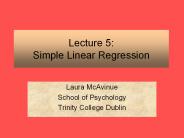Lecture 6 Correlation - PowerPoint PPT Presentation
1 / 13
Title:
Lecture 6 Correlation
Description:
Lecture 6 Correlation Stock example: stock prices are likely to be correlated. Need a measure of strength of correlation. Microarray example Defining correlation : – PowerPoint PPT presentation
Number of Views:58
Avg rating:3.0/5.0
Title: Lecture 6 Correlation
1
Lecture 6 Correlation
Stock example stock prices are likely to be
correlated. Need a measure of strength of
correlation.
- Microarray example
- Defining correlation
- Procedure of computing correlation
- (1)standardize x, (2)standardize y, (3)average
product of standardized x and standardized y - properties. between -1 and 1
- Three special cases perfect positive
relationship 1, perfect negative relationship
-1 and no correlation 0 - Back to the stock example.
2
Definition of correlation coefficient
Correlation remains the same under any scale
changes
If X and Y both have mean 0 and variance 1, then
correlation coefficient r E (XY)
For the general case, standardize each variable
first.
If you forgot to divide by SD, then you obtained
a quantity called Covariance, which is still
useful (see next page)
Cov (X, Y) E (X-mean of X)(Y-mean of Y)
Without subtracting the mean, you got E(XY), a
garbage ! A remedy cov(X,Y) E(XY) - E(X)
E(Y)
3
Correlation coefficient cov(X,Y)/SD(X)SD(Y),
wherecov(X,Y) E (X-mean) (Y-mean)
- Use the independence example (from lecture 4) to
construct positive correlation by cutting of the
points on the edge - Do a step by step calculation of corr. Coeff.
- Do a plotting showing 4 quadrants by drawing
vertical and horizontal lines passing the means.
4
Productnegative
Productpositive
(-, ) X lower than mean Y higher than mean
(, ) X, Y both higher than mean
(, -) X higher than mean, Y lower than mean
(-, -) X,Y both lower than mean
Productnegative
Productpositive
5
Conceptual Step by step for Corr Coeff.Stdzd
standardized (remove mean, divided by SD)
Consistency if use n-1 in doing SD, then use
n-1 for averaging product
x y stdzd x stdzd y product
2 4 -5/SD(X) -1.5/SD(Y) 7.5/SD(X)SD(Y)
4 3 -3/SD(X) -2.5/SD(Y) 7.5/SD(X)SD(Y)
6 6 -1/SD(X) 0.5/SD(Y) -0.5/SD(X)SD(Y)
8 5 1 /SD(X) -0.5/SD(Y) -0.5/SD(X)SD(Y)
10 8 3/SD(X) 2.5/SD(Y) 7.5/SD(X)SD(Y)
12 7 5/SD(X) 1.5/SD(Y) 7.5/SD(X)SD(Y)
X-EX
Y-EY
-1.5 -2.5 0.5 -0.5 2.5 1.5
-5 -3 -1 1 3 5
Corr(29/6)/3.4 times 1.729/350.828
E X7
E Y5.5
SD( X) sqrt(35/3)3.4
SD(Y)1.7
Use population version, so divided by n
6
Practice Step by step for Covariance,variance,
and correlation coefficients.
Consistency if use n-1 in doing SD, then use
n-1 for averaging product
x y X-EX Y-EY product (X-EX)2 (Y-EY)2
2 4 -5 -1.5 7.5 25 2.25
4 3 -3 -2.5 7.5 9 6.25
6 6 -1 0.5 -0.5 1 0.25
8 5 1 -0.5 -0.5 1 0.25
10 8 3 2.5 7.5 9 6.25
12 7 5 1.5 7.5 25 2.25
Cov 29/6
SD( X) 3.4 sqrt(35/3)3.4
SD(Y)1.7
Corr0.828 cov/sd(x)sd(y)
E X7
E Y5.5
Use population version, so divided by n
7
Positive correlations
- Corr 0.9
- Corr .8
- Corr .5
On line illustration with Xlispstat,
using (bi-normal r n)
8
Algebra for Variance, covariance
- Var(XY) Var X Var Y 2 cov (X,Y)
- Var(X) Cov (X, X)
- Var (Xa) Var (X)
- Cov (Xa, Y b) Cov(X,Y)
- Cov (aX, bY)ab Cov(X,Y)
- Var(aX) a2 Var (X)
- Cov( XY, Z) cov(X,Z) cov (Y,Z)
- Cov (XY, VW) cov(X,V) cov (X, W) cov (Y,
W) cov(Y,W)
TRICK pretend all means are zero
(XY)(VW)XVXWYWYW
9
Stock prices are correlated
- Effect on variance of option 1 and option
- Recall the problem
10
Example
- Stock A and Stock B
- Current price both the same, 10 per share
- Predicted performance a week later similar
- Both following a normal distribution with
- Mean 10.0 and SD 1.0
- You have twenty dollars to invest
- Option 1 buy 2 shares of A portfolio
mean?, SD? - Option 2 buy one share of A and one share of B
- Which one is better? Why?
Assume that there is a correlation of .8 between
the prices of stock A and stock B a week later
11
Better? In what sense?
- What is the probability that portfolio value will
be higher than 22 ? - What is the probability that portfolio value will
be lower than 18? - What is the probability that portfolio value will
be between18 and 22?
(How about if correlation equals 1 ?)
12
For option 2, the key is to find variance
- Let X be the future price of stock A
- Let Y be the future price of stock B
- Let T X Y portfolio value
- E T E X E Y (same as done before)
- Var T Var X Var Y 2 cov (X, Y)
- Cov (X, Y) correlation times SD(X) SD(Y) .8
times 1 times 1 0.8 - Var X (SD (X) )2121 Var Y 1
- Var T 1 1 2 times .8 3.6 (compared to
112 when assuming independence)
SD (T) squared root of 3.61.9 is still less
than SD for option 1
13
Index
- Index is usually constructed as a weighted
average of several variables - Stock index
- Course grade .2 midterm .45 Final .15 HW
.2 LAB - Find SD of course grade
- Independence dependence






























